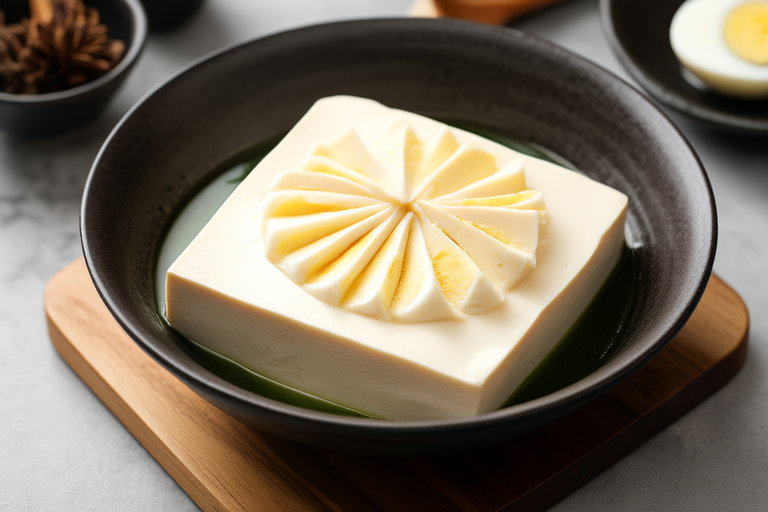Elegant Comfort: Silken Tofu with Preserved Egg and Dashi Broth
Introduction:
In the culinary world, few dishes manage to encapsulate both elegance and comfort as gracefully as Silken Tofu with Preserved Egg and Dashi Broth. This dish, originating from Japanese cuisine but with influences from Chinese gastronomy, is a testament to the harmonious balance of flavors and textures. It is not just a meal; it’s an experience that warms the soul and tantalizes the taste buds. The combination of soft, silky tofu, the umami-rich dashi broth, and the salty, savory preserved egg creates a symphony of tastes that is both soothing and satisfying.
This recipe is designed for those who appreciate the artistry of cooking and the subtle nuances of flavor. Whether you’re a seasoned chef or a beginner in the kitchen, this dish offers a rewarding challenge and a delightful result. Let’s dive into the ingredients, preparation techniques, and the cultural significance behind this exquisite dish.
Ingredients:
- 1 block (400g) silken tofu
- 2 preserved eggs (also known as century eggs)
- 1 liter dashi broth (or homemade dashi using kombu seaweed and bonito flakes)
- 2 tablespoons soy sauce
- 1 tablespoon mirin (sweet rice wine)
- 1 teaspoon sugar
- 2 spring onions, finely chopped
- 1 teaspoon sesame oil
- Freshly ground white pepper to taste
- Garnishes: chopped green onions, sesame seeds, and shiso leaves (optional)
Note: Ensure that your ingredients are of high quality. For instance, the dashi should be made from fresh kombu and bonito flakes to ensure the best flavor. The preserved eggs should have a firm texture and a rich, deep flavor. The silken tofu should be fresh and smooth.
Preparation:
- Prepare the Tofu: Gently remove the silken tofu from its packaging and place it on a plate lined with paper towels. Pat the tofu dry to remove excess moisture. Slice the tofu into 1-inch cubes.
- Prepare the Preserved Eggs: Peel the preserved eggs and cut them into quarters. Set aside.
- Make the Dashi Broth: If you are using store-bought dashi, skip to step 4. Otherwise, prepare the dashi by simmering a piece of dried kombu seaweed in 1 liter of water for about 10 minutes. Remove the kombu and add bonito flakes. Simmer for another 3-5 minutes, then strain the broth through a fine mesh sieve.
- Simmer the Broth: In a large pot, combine the dashi broth, soy sauce, mirin, and sugar. Bring the mixture to a gentle simmer over medium heat.
- Combine Ingredients: Carefully add the tofu cubes and preserved egg pieces to the simmering broth. Let them cook gently for about 5 minutes, ensuring they are heated through without breaking apart.
- Seasoning and Garnishing: Once the tofu and eggs are heated, remove the pot from the heat. Drizzle with sesame oil and sprinkle with freshly ground white pepper. Garnish with chopped spring onions and optional toppings like sesame seeds and shiso leaves.
Tips for Success:
- Handle the tofu gently to avoid breaking it. Use a slotted spoon when transferring it to the broth.
- The preserved eggs should be added towards the end of cooking to retain their texture.
- The dashi broth is crucial for the flavor profile. Make sure it is well-balanced and not too salty.
Cultural Significance:
The combination of ingredients in this dish reflects a fusion of Japanese and Chinese culinary traditions. Silken tofu, a staple in Chinese cuisine, is used here for its delicate texture and neutral flavor, which complements the strong umami of the dashi and the unique taste of the preserved eggs.
Preserved eggs, also known as century eggs, have been part of Chinese cuisine for centuries. They are valued for their complex flavor and are often associated with longevity and health. In this dish, they add a layer of depth and richness that elevates the overall taste.
Dashi, the backbone of Japanese cooking, is a clear soup stock made from dried kelp and fish flakes. It provides the essential umami flavor that is central to Japanese cuisine. The use of dashi in this dish bridges the gap between the two cultures, creating a dish that is both familiar and exotic.
Serving Suggestions:
This dish is traditionally served at room temperature or slightly warm. It pairs beautifully with steamed rice or noodles. For a more substantial meal, consider serving it alongside a simple salad or pickled vegetables.
If you want to enhance the presentation, serve the tofu and eggs in individual bowls, garnished with fresh herbs and a drizzle of sesame oil. This dish is perfect for a light lunch or a comforting dinner, especially on cooler days.
Nutritional Information:
This dish is relatively low in calories and fat, making it a healthy choice for those watching their intake. However, it is rich in protein and essential nutrients due to the tofu and preserved eggs. Each serving contains approximately 150 calories, 9 grams of protein, and 8 grams of fat.
For those with dietary restrictions, this dish can be easily adapted. You can substitute the dashi broth with vegetable stock for a vegetarian option or use tamari instead of soy sauce for a gluten-free version.
Conclusion:
Silken Tofu with Preserved Egg and Dashi Broth is a dish that embodies the essence of culinary harmony. It is a testament to the beauty of combining different culinary traditions to create something truly special. By following this recipe, you can enjoy a dish that is not only delicious but also culturally enriching. Whether you’re hosting a dinner party or simply treating yourself to a quiet evening at home, this dish will leave a lasting impression.


